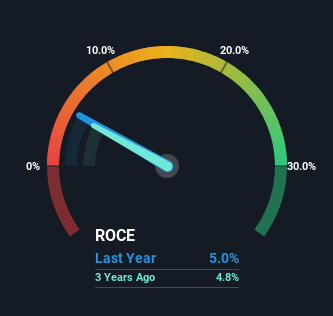Trifast (LON:TRI) Might Be Having Difficulty Using Its Capital Effectively
If you're not sure where to start when looking for the next multi-bagger, there are a few key trends you should keep an eye out for. In a perfect world, we'd like to see a company investing more capital into its business and ideally the returns earned from that capital are also increasing. Ultimately, this demonstrates that it's a business that is reinvesting profits at increasing rates of return. However, after briefly looking over the numbers, we don't think Trifast (LON:TRI) has the makings of a multi-bagger going forward, but let's have a look at why that may be.
What Is Return On Capital Employed (ROCE)?
For those who don't know, ROCE is a measure of a company's yearly pre-tax profit (its return), relative to the capital employed in the business. The formula for this calculation on Trifast is:
Return on Capital Employed = Earnings Before Interest and Tax (EBIT) ÷ (Total Assets - Current Liabilities)
0.05 = UK£11m ÷ (UK£257m - UK£45m) (Based on the trailing twelve months to September 2023).
Thus, Trifast has an ROCE of 5.0%. In absolute terms, that's a low return and it also under-performs the Machinery industry average of 13%.
See our latest analysis for Trifast
In the above chart we have measured Trifast's prior ROCE against its prior performance, but the future is arguably more important. If you'd like to see what analysts are forecasting going forward, you should check out our free analyst report for Trifast .
How Are Returns Trending?
On the surface, the trend of ROCE at Trifast doesn't inspire confidence. Around five years ago the returns on capital were 15%, but since then they've fallen to 5.0%. However it looks like Trifast might be reinvesting for long term growth because while capital employed has increased, the company's sales haven't changed much in the last 12 months. It's worth keeping an eye on the company's earnings from here on to see if these investments do end up contributing to the bottom line.
On a related note, Trifast has decreased its current liabilities to 17% of total assets. That could partly explain why the ROCE has dropped. Effectively this means their suppliers or short-term creditors are funding less of the business, which reduces some elements of risk. Some would claim this reduces the business' efficiency at generating ROCE since it is now funding more of the operations with its own money.
The Bottom Line On Trifast's ROCE
Bringing it all together, while we're somewhat encouraged by Trifast's reinvestment in its own business, we're aware that returns are shrinking. And in the last five years, the stock has given away 54% so the market doesn't look too hopeful on these trends strengthening any time soon. Therefore based on the analysis done in this article, we don't think Trifast has the makings of a multi-bagger.
If you'd like to know about the risks facing Trifast, we've discovered 2 warning signs that you should be aware of.
While Trifast isn't earning the highest return, check out this free list of companies that are earning high returns on equity with solid balance sheets.
Have feedback on this article? Concerned about the content? Get in touch with us directly. Alternatively, email editorial-team (at) simplywallst.com.
This article by Simply Wall St is general in nature. We provide commentary based on historical data and analyst forecasts only using an unbiased methodology and our articles are not intended to be financial advice. It does not constitute a recommendation to buy or sell any stock, and does not take account of your objectives, or your financial situation. We aim to bring you long-term focused analysis driven by fundamental data. Note that our analysis may not factor in the latest price-sensitive company announcements or qualitative material. Simply Wall St has no position in any stocks mentioned.

